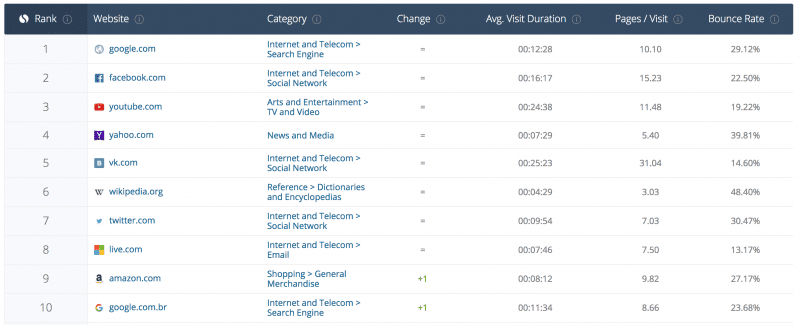Do you know for most people in the world, to search something is to Google it? No wonder, Google .com is the world’s most visited website ahead of Facebook.com, the social media network. Well, you can google it if you don’t believe me.
That’s not it, Google has been sitting on top of the list for ages and has witnessed many websites come and go off that list. Currently, here are the top 10 websites in the world according to SimilarWeb –

If we look at the top 3 sites, it’s a mix of a search engine and social media portals. And out of the top 3 sites, two are Google (now Alphabet) properties. What does that mean for an average internet user?
Well, according to a survey released by RedShift Research and GoDaddy, 59% of businesses that own a website said their business grew once they had built their Website. Micro, small and medium businesses can use a website, social media, or a combination of both to connect with their target audience. If your business today neither has a dedicated website nor a social media page, it is difficult to stand out amidst the increasingly intense competitive environment.
In order to build an online presence for your business, the first step is to register your company’s domain name. It’s beneficial to choose a top level domain (TLD) extension (e.g., .com, .net, .tv) that customers know and trust. Once you have a domain name, you can either redirect visitors to a social media page or build a brand new website with a customised design and user interface.
Let’s see how both of these methods work:
Social Media
There is no cost involved in creating a social media page. However, it does not give you a domain name, which is your virtual business identity. You may register a .com domain name for your business at a nominal cost and then redirect it to your social media page. This is an easy and cost effective method to get a branded online identity.
The key benefits of this method are:
- Cost benefits: You are only paying for a domain name; social media pages are free of cost
- Low commitment: Switching to a different social media platform is easy. Your domain name can be your main online identity and you can use it to redirect to a new platform
- Expanded reach: It’s a great way to reach a large number of existing and potential consumers
- Flexibility: If you wish to have a full-fledged website in the future, you can delink your domain from any social media platform and set up a standalone website which can link to your social media page
- E-commerce features: Most social media pages now come with e-commerce functionalities. This means that you can directly sell from your social media page.
Content on your social media page, however, is governed by the terms and conditions of the social media platform. Social media pages work as an open forum, where consumers can freely voice feedback, concerns and brand perceptions. Your social media page provides interaction with your target audience and therefore, drives higher engagement. However, with social media, you need to continuously monitor feedback and address it promptly. Lastly, with limited design features to showcase your products and services, your social media page may be unable to carry the brand message in its entirety.
Website
According to a 2015 Verisign survey, 77% of small businesses which are online believe that their online identity enhances the credibility of their company. However, Indian SMBs are still lagging behind their global peers by a huge margin when it comes to building an online presence. This is mainly due to lack of awareness about the costs and benefits associated with having a website. Unlike a social media page, your website reflects your brand in its design, user interface, and messaging. With plenty of free as well as paid options available, building a website is extremely easy.
While free website builder tools let you choose from an array of existing templates, an experienced web developer can customise the features as per your needs at an additional cost. You can host blogs, videos, customer reviews, special promotional offers, etc. on your .com website.
Website and Social: Working Together
However, once your website and social media page are running together, you can leverage benefits across both. Your website can be the epicentre of all your brand communication while your social media page and other marketing channels, such as email and paid search, can be used to engage and redirect customers back to your website. Here is how to integrate your website and social media strategy:
- Engage with your target audience on social media. You can initiate relevant conversations here and prompt them to check your website
- The Search Engine Optimisation(SEO) capabilities of your website will make your brand more discoverable and social media can provide further visibility to your brand
- Add share buttons on your website to share your content on social media. For e-commerce businesses, integrate social buttons on product pages so your customers can share socially what they just bought or like on your website

To reach out to your potential customers and influence their buying decisions in your favour, use your .com website to be discovered and engage with them through your social media page. So, get yourself a .com and start connecting now with customers and potential customers who matter the most.











